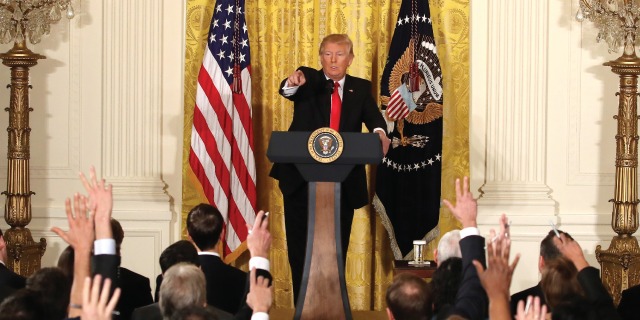
Overview updated October 2017 with new chart
In an era when Americans’ choices about whom to turn to and trust for news are often divided along political lines, a new Pew Research Center study of media coverage of the early days of the Trump administration finds those preferences can be significant.
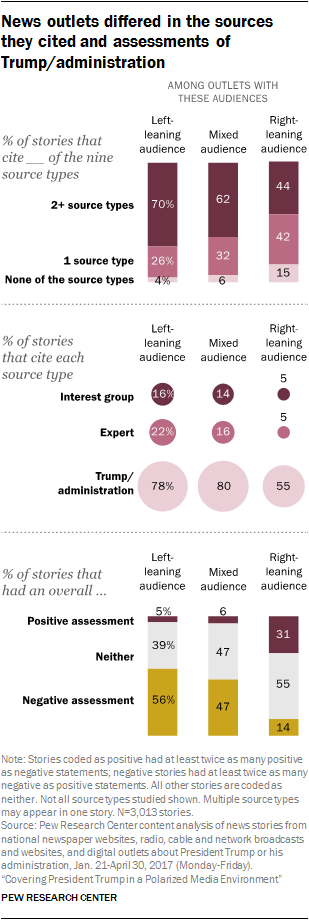
News outlets whose audience leans to the left politically, those whose audience leans to the right and those appealing to a more mixed audience covered a similar news agenda and mostly framed their coverage around character and leadership rather than policy. But the types of sources included in the stories and the assessments of the administration’s words and actions often differed, according to this study of more than 3,000 news stories during the first 100 days of the Trump presidency across 24 media outlets with content from television, radio and the web.
Specifically, outlets with a right-leaning audience cited fewer types of sources in their reporting, offered more positive and fewer negative evaluations of President Donald Trump and his administration, and had reporters who were less likely to challenge something the president said than outlets whose audience leans to the left or those with a more evenly distributed audience.
Seven-in-ten stories from outlets with a left-leaning audience and 62% from those with a more mixed audience included at least two of nine types of sources evaluated, such as a member of the administration, a member of Congress, or an outside expert. That was true, however, of less than half the stories (44%) from outlets with a right-leaning audience. In particular, outlets whose audience leans right of center were less likely to include Trump and his administration, outside experts or interest groups as sources. They were also about half as likely to include voices from both Democratic and Republican members of Congress (7% of stories vs. 14% for outlets with a left-leaning audience and 15% for outlets with a more mixed audience).
Within a news story, the statements from the sources cited – and what reporters choose to quote from them – as well as the reporter’s own language formulate the overall assessment of the Trump administration. During the time period studied, stories from outlets with a right-leaning audience were at least five times more likely to carry an overall positive evaluation of Trump’s words or actions (defined as stories that contained at least twice as many positive statements as negative ones) than stories from outlets with a left-of-center or more mixed audience (31% vs. 5% and 6%, respectively). They were also at least three times less likely to carry negative assessments (14% vs. 56% and 47%, respectively). Still, most stories from outlets with a right-leaning audience (55%) carried neither a positive nor negative assessment of the president.
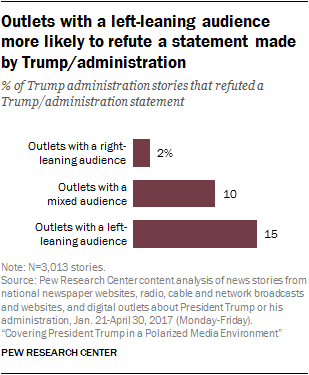 Another area of difference is the degree to which the reporter of a story directly refuted or corrected a statement by President Trump or a member of the administration. Overall, this occurred in one-in-ten stories, but it was about seven times as common in stories from outlets with a left-leaning audience (15%) than right-leaning ones (2%), while outlets with a more mixed audience fell in the middle (10%).
Another area of difference is the degree to which the reporter of a story directly refuted or corrected a statement by President Trump or a member of the administration. Overall, this occurred in one-in-ten stories, but it was about seven times as common in stories from outlets with a left-leaning audience (15%) than right-leaning ones (2%), while outlets with a more mixed audience fell in the middle (10%).
For this study, researchers categorized 24 news outlets into three groups by the political makeup of their audiences: Outlets whose audience – as measured using Pew Research Center surveys – consists of two-thirds more members who are right of center politically than left, two-thirds who are more left of center than right, and outlets with a more evenly distributed audience base. (For more details on the outlet selection process and groupings see the box below or the methodology.)
The selection and grouping of news outlets
Researchers selected outlets for inclusion in the study based on audience reach. For all online outlets, researchers selected sites with at least 20 million average unique monthly visitors during November and December of 2016 and at least 15 million from the first quarter of 2017, according to comScore data. From that list, researchers excluded sites that did not largely focus on political or general news. For newspaper websites, five top tier newspapers – based on total circulation according to the Alliance for Audited Media – that offer daily coverage of national affairs and met the same website traffic thresholds were included. For cable, four evening programs from each of the three networks (CNN, Fox News and MSNBC) were selected. Broadcast television includes the nightly news from all three networks plus PBS. Within radio, researchers selected the top two talk radio shows by ratings, according to Talkers.com, as well as the morning and afternoon news programs from NPR. Websites for TV and radio outlets were also included if they met the same threshold as digital-native outlets. The volume of content sampled for each outlet was based on factors such as audience reach and the amount of news content produced on a daily basis.
To be included in the sample, stories needed to be at least 50% about the president and his administration and more than 100 words or at least 30 seconds long. Digital stories were selected based on their prominence and position on the home page. For television and radio, every third qualifying story during the first half hour of a program was studied. Specified editorial or opinion sections or segments were not included, but individual opinion stories not set apart in a designated opinion section were included.
Each news outlet was placed in one of three groups based on the profile of its audience: outlets whose audience leans to the left politically, outlets whose audience leans to the right politically, and outlets appealing to a more mixed audience. The audience data came from one of two recent Pew Research Center surveys in which U.S. adults were asked if they regularly got news about the election or politics from each outlet. An outlet was classified as left-leaning if its audience included at least two-thirds more liberal Democrats than conservative Republicans. Conversely, if the audience had two-thirds more conservative Republicans than liberal Democrats, the outlet was categorized as right-leaning. If neither liberal Democrats nor conservative Republicans made up at least two-thirds more of the audience than the other, the outlet was included in the mixed-audience group. This resulted in 12 outlets with a left-leaning audience, five with a right-leaning audience and seven with a more mixed audience.
Details on the inclusion process, content sampled and the full list of outlets can be found in the methodology.
Overall, five specific topics dominated coverage about Trump and the administration
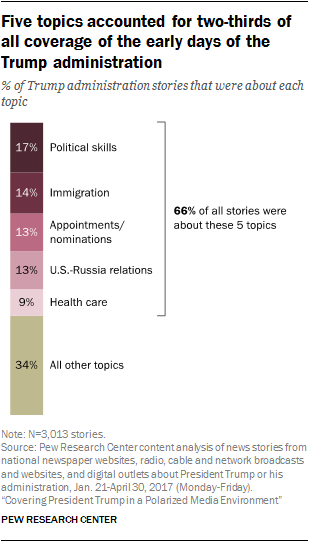 Looking at the total coverage across all 24 outlets, five topics accounted for two-thirds of the coverage during this time period (Jan. 21-April 30): stories about the president’s political skills (17%), immigration (14%), presidential appointments and nominations (13%), U.S.-Russia relations (13%), and health care (9%). None of the remaining 39 topics accounted for more than 4% of stories.
Looking at the total coverage across all 24 outlets, five topics accounted for two-thirds of the coverage during this time period (Jan. 21-April 30): stories about the president’s political skills (17%), immigration (14%), presidential appointments and nominations (13%), U.S.-Russia relations (13%), and health care (9%). None of the remaining 39 topics accounted for more than 4% of stories.
Stories of the president’s political skills spanned a wide range of issues and events, such as the delivery of his first speech to a joint session of Congress and his management of White House staff. The president’s executive order limiting the entry of travelers from certain countries and the legal challenges to it constituted a large portion of stories about immigration.
Allegations about Russia and the 2016 election tied to Trump and his administration, as well as the White House’s relationship with Moscow, dominated stories on U.S.-Russia relations. Appointments and nominations included stories about various cabinet members and Supreme Court Justice Neil Gorsuch. Health care coverage often addressed efforts by Trump and the Republicans to move health care legislation through Congress. A more detailed look at coverage of these most prominent topics occurs below.
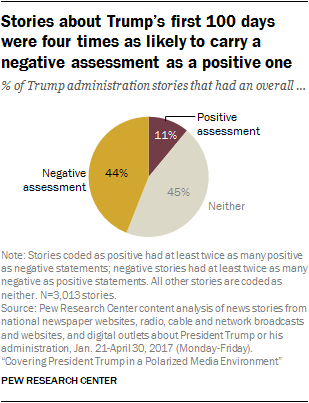
When reporting on any event, a reporter can choose any number of ways to orient the storyline. This study classified stories into one of two main frames: the president’s leadership and character or his core ideology and policy agenda. Overall, journalists structured their narratives far more around President Trump’s leadership and character than his policy agenda (74% vs. 26%, respectively).

What’s more, only about one-in-ten stories (11%) delivered an overall positive assessment of the administration’s words or actions. Four times as many (44%) offered a negative assessment, while the remaining 45% were neither positive nor negative.
The study also found that, overall, Trump and his administration played a large role in the stories that ended up getting reported on each day. Nearly half the time (45% of all stories) the reporter produced the piece in response to something the president or his staff said or did. The news media itself spurred 19% of stories, either through self-initiated investigative reporting or through an action or statement by a member of the news media.
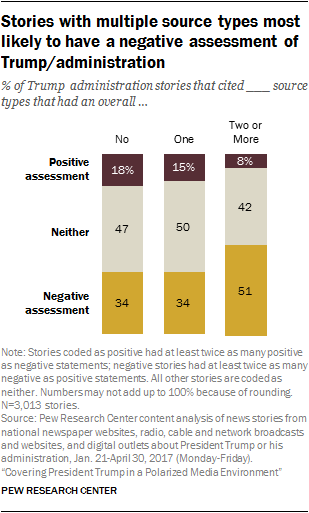
When choosing who to include as voices in a story, journalists cited the president or a member of his administration more frequently than any other source type. Nearly three-quarters (74%) of all stories included at least one source from the administration. The next most common type of source, though occurring about half as frequently, was another news organization or journalist (35%), followed by Republican and Democratic members of Congress (26% and 21%, respectively). Sources outside of government and media were less common, with experts cited in 16% of stories, interest groups in 13% and citizens in just 5%.
Overall, a majority of coverage (62%) included at least two of the nine types of sources studied, but just 29% included three or more.
Another nuance in the findings highlights the relationship between the number of different source types included in a story and the assessment of the administration. Overall, stories with two or more source types were more likely than stories with fewer source types to have an overall negative assessment – about half (51%) of stories with two or more source types, compared with about a third (34%) of those that had zero or one source type. In other words, stories with a greater mix of voices were more likely to have an overall negative sense of the president’s actions or statements.
Finally, amid America’s experience with a president who regularly uses Twitter as a way of communicating directly with the public, roughly one-in-six stories (16%) contained a direct tweet from President Trump.
Compared with past administrations, coverage of Trump’s early days focused less on policy and was more negative overall
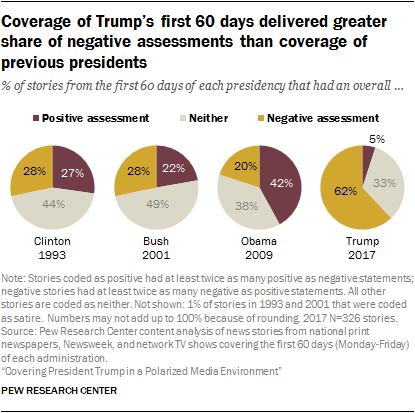 The Center has also conducted similar analyses for the early months of the three prior administrations: those of Barack Obama, George W. Bush and Bill Clinton. But for each succeeding president, the media universe has expanded dramatically. While today, for example, about nine-in-ten U.S. adults (89%) get at least some news online, just 14% of Americans even reported using the internet in 1995 during Clinton’s first term. Thus, in addition to the examination of how the broad news media landscape covered and assessed the first 100 days of the Trump administration, the study also looked for historical comparisons of coverage of the first 60 days across a smaller universe of outlets that existed during all four time points, representing a mix of print publications and network evening news.
The Center has also conducted similar analyses for the early months of the three prior administrations: those of Barack Obama, George W. Bush and Bill Clinton. But for each succeeding president, the media universe has expanded dramatically. While today, for example, about nine-in-ten U.S. adults (89%) get at least some news online, just 14% of Americans even reported using the internet in 1995 during Clinton’s first term. Thus, in addition to the examination of how the broad news media landscape covered and assessed the first 100 days of the Trump administration, the study also looked for historical comparisons of coverage of the first 60 days across a smaller universe of outlets that existed during all four time points, representing a mix of print publications and network evening news.
Compared with the three prior presidencies, coverage of Trump’s early days in office moved further away from a focus on the policy agenda (31% of stories, compared with 50% for Obama, 65% for Bush and 58% for Clinton) and toward character and leadership. And the evaluations of President Trump were far more negative and less positive than those of his predecessors.
Elements of coverage studied
This study examined how the news media covered the first 100 days of President Trump and his administration from Jan. 21 through April 30, 2017. Researchers coded stories from the 24 news outlets – with content pulled from more than 40 specific programs or websites – for a number of measures:
Trigger: This measure identifies the actor responsible for the action, event or editorial decision that initiated a story’s production. For instance, a story about health care may have been triggered by a speech by the president or a new bill written by a Republican member of Congress. In the first case, the trigger would be the Trump administration, while in the second it would be congressional Republicans. There were 12 different types of triggers identified in this study.
Topic: News stories were first coded as being about one of 44 specific topics or storylines (the most prominent topic within each story was coded as the story’s overall topic), which then were grouped into three broad topic categories: 1) Domestic issues 2) foreign affairs and 3) the president’s management and political approach.
Frame: When reporting a story about a specific topic, there are various frames that journalists can use to orient the narrative. This study classified stories into one of two main frames (whichever accounted for more than 50% of the story): 1) the president’s leadership and character or 2) his core ideology and policy agenda. For example, an article or segment about health care could be framed around the legislative differences in what the administration is proposing versus members of Congress (thus coded as core ideology and policy agenda). Or, such a story could be framed around the evaluation of the president in terms of his outreach to and relationship with members of Congress, which would then be coded as leadership and character.
Source types: The study also measured nine different types of sources that might be cited in a story: 1) Trump or a member of the administration, 2) the Trump organization or a family member (not in the administration), 3) a congressional Democrat, 4) a congressional Republican, 5) an issue-based group or interest group, 6) an expert, 7) a poll, 8) a journalist (other than the reporter or anchor of the story) or news organization, and 9) a citizen. This measure identifies the presence of a type of source in any given article, not the total number of individual sources. There could be more than one source within any source category, such as quotes from two members of the administration. There may also have been sources used outside the types listed above that were not captured in this study.
Assessment of the Trump administration: In this analysis, each statement in a story (made by a source or the reporter him or herself) was analyzed to determine how, if at all, it assessed President Trump and his administration’s actions or words. Within a story, there needed to be at least twice as many positive as negative statements for a story to be considered positive and vice versa to be considered negative. If this threshold was not met, stories were coded as neither positive nor negative.
Refutations: The news media can play a fact checking role in its coverage of politics and, in the course of that fact checking, can sometimes indicate that a statement is inaccurate or a misrepresentation. Accordingly, this measure identifies any instance in which the journalist directly challenges a statement made by Trump or a member of his administration, by saying it is incorrect.
Trump tweets: This measure identifies whether a story included a direct tweet from President Trump, either cited in text or repeated verbally.


